
S&P 500
A green daily candlestick was expected for Friday’s session. Although the candlestick printed green, the session saw a lower low that was not expected.
Overall, the Elliott wave count remains the same with price remaining well above the invalidation point. The AD line and On Balance Volume continue to support the Elliott wave analysis.
Summary: A new all time high from On Balance Volume at the weekly chart level is extremely bullish, so expect upwards movement next week. There is also bullish divergence now between price and the AD line and VIX, signalling upwards movement to start next week.
The first short term target is now at 2,814. The second short term target is at 2,915. At one of these targets a sideways consolidation to last about a week is expected.
The mid to longer term target is at 2,922 (Elliott wave) or 3,045 (classic analysis). Another multi week to multi month correction is expected at one of these targets.
The final target for this bull market to end remains at 3,616.
The Elliott wave count has good support from classic technical analysis. New all time highs this week from On Balance Volume and the AD line add strong confidence to this analysis.
Pullbacks are an opportunity to join the trend.
Always practice good risk management. Always trade with stops and invest only 1-5% of equity on any one trade.
The biggest picture, Grand Super Cycle analysis, is here.
Last historic analysis with monthly charts is here, video is here.
ELLIOTT WAVE COUNT
WEEKLY CHART
Cycle wave V must complete as a five structure, which should look clear at the weekly chart level and also now at the monthly chart level. It may only be an impulse or ending diagonal. At this stage, it is clear it is an impulse.
Within cycle wave V, the third waves at all degrees may only subdivide as impulses.
Intermediate wave (4) has breached an Elliott channel drawn using Elliott’s first technique. The channel is redrawn using Elliott’s second technique: the first trend line from the ends of intermediate waves (2) to (4), then a parallel copy on the end of intermediate wave (3). Intermediate wave (5) may end either midway within the channel, or about the upper edge.
Intermediate wave (4) may now be a complete regular contracting triangle lasting fourteen weeks, one longer than a Fibonacci thirteen. There is perfect alternation and excellent proportion between intermediate waves (2) and (4).
Within intermediate wave (5), no second wave correction may move beyond the start of its first wave below 2,594.62.
DAILY CHART
It is possible that intermediate wave (4) is a complete regular contracting triangle, the most common type of triangle. Minor wave E may have found support just below the 200 day moving average and ending reasonably short of the A-C trend line. This is the most common look for E waves of triangles.
Intermediate wave (3) exhibits no Fibonacci ratio to intermediate wave (1). It is more likely then that intermediate wave (5) may exhibit a Fibonacci ratio to either of intermediate waves (1) or (3). The most common Fibonacci ratio would be equality in length with intermediate wave (1), but in this instance that would expect a truncation. The next common Fibonacci ratio is used to calculate a target for intermediate wave (5) to end.
Price has clearly broken out above the upper triangle B-D trend line. This indicates that it should now be over if the triangle is correctly labelled.
A trend line in lilac is added to this chart. It is the same line as the upper edge of the symmetrical triangle on the daily technical analysis chart. Price has found support about this line at the last two small swing lows. The suppport at this line has reasonable technical significance now that it has been tested twice, and this line should be assumed to continue to provide support until proven otherwise.
Sometimes the point at which the triangle trend lines cross over sees a trend change. A trend change at that point may be a minor one or a major one. That point is Friday, and it may signal the end of minute wave iv.
Minor wave 3 may only subdivide as an impulse, and within it the subdivisions of minute waves ii and iv may show up as one or more red daily candlesticks or doji.
Within minor wave 3, no second wave correction may move beyond the start of its first wave below 2,676.81. Along the way up, any deeper corrections may now find support at the lower edge of the base channel drawn about minor waves 1 and 2. Minor wave 3 may have the power to break above the upper edge of the base channel. If it does, then that upper edge may then provide support.
TECHNICAL ANALYSIS
WEEKLY CHART

Click chart to enlarge. Chart courtesy of StockCharts.com.
The small doji candlestick on its own is not a reversal signal. A doji signals a pause, a balance between bulls and bears.
Much weight in this analysis this week will be given to the new all time high for On Balance Volume. This is extremely bullish. It is likely that price shall follow through within a few weeks to new all time highs.
This chart is very bullish.
DAILY CHART

Click chart to enlarge. Chart courtesy of StockCharts.com.
The symmetrical triangle may now be complete. The base distance is 340.18. Added to the breakout point of 2,704.54 this gives a target at 3,044.72. This is above the Elliott wave target at 2,922, so the Elliott wave target may be inadequate.
The purple support line on On Balance Volume is slightly adjusted to be as conservative as possible (there is some leeway in exactly how that line may be drawn). As it is drawn here, the support line may be offering some support.
Overall, this chart is more bullish and neutral. Only the volume spike for Friday is bearish.
VOLATILITY – INVERTED VIX CHART
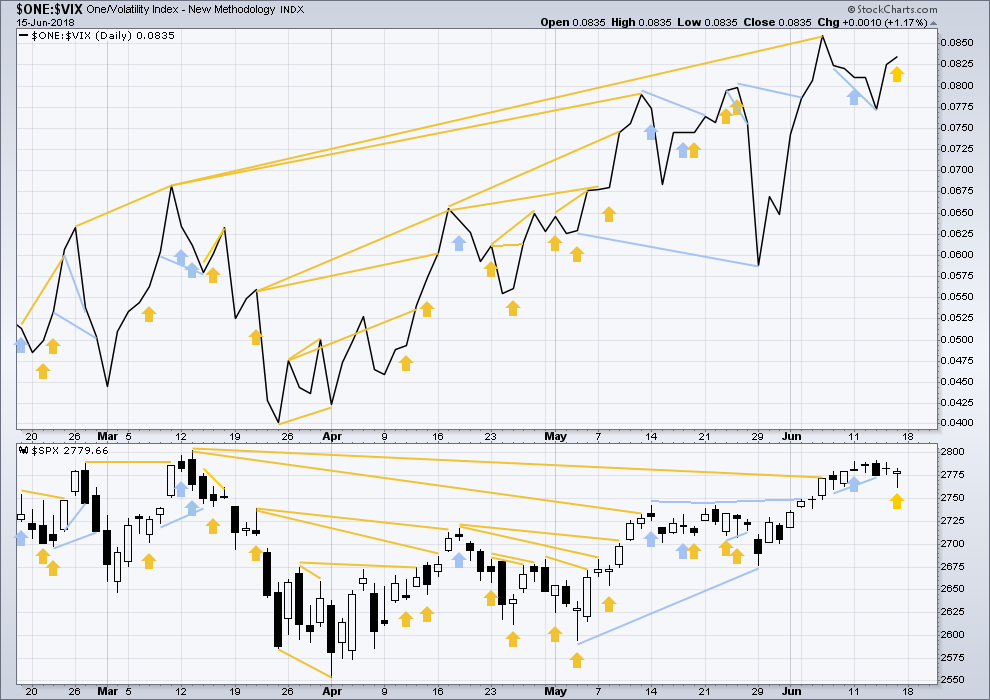
Click chart to enlarge. Chart courtesy of StockCharts.com. So that colour blind members are included, bearish signals
will be noted with blue and bullish signals with yellow.
Normally, volatility should decline as price moves higher and increase as price moves lower. This means that normally inverted VIX should move in the same direction as price.
Inverted VIX has made a new high above the prior swing high of the 9th of March, but price has not made a corresponding new swing high about the same point yet. This divergence is bullish. Inverted VIX is still a little way off making a new all time high.
Price moved lower on Friday, but inverted VIX moved higher. This divergence is bullish and supports the Elliott wave count.
BREADTH – AD LINE

Click chart to enlarge. Chart courtesy of StockCharts.com.
There is normally 4-6 months divergence between price and market breadth prior to a full fledged bear market. This has been so for all major bear markets within the last 90 odd years. With no longer term divergence yet at this point, any decline in price should be expected to be a pullback within an ongoing bull market and not necessarily the start of a bear market. New all time highs from the AD line means that any bear market may now be an absolute minimum of 4 months away. It may of course be a lot longer than that. My next expectation for the end of this bull market may now be October 2019.
Small caps and mid caps have both made new all time highs. It is large caps that usually lag in the latter stages of a bull market, so this perfectly fits the Elliott wave count. Expect large caps to follow to new all time highs.
Breadth should be read as a leading indicator.
Price and the AD line moved slightly lower. Price has made a new low below the low two sessions prior, but the AD line has not. This divergence is bullish and supports the Elliott wave count.
Overall, the AD line still remains mostly bullish as it has made more than one new all time high this week. Price may reasonably be expected to follow through in coming weeks.
DOW THEORY
The following lows need to be exceeded for Dow Theory to confirm the end of the bull market and a change to a bear market:
DJIA: 23,360.29.
DJT: 9,806.79.
S&P500: 2,532.69.
Nasdaq: 6,630.67.
Only Nasdaq at this stage is making new all time highs. DJIA and DJT need to make new all time highs for the ongoing bull market to be confirmed.
GOLD
Downwards movement fits the alternate Elliott wave count, which was expected to have a lower probability.
Low probability does not mean no probability; when low probability outcomes do occur, they will never be expected as what was most likely. That is the nature of probability.
Summary: If price continues a little lower, then the target may be about 1,273. Look for price, if it gets down that low, to find very strong support about the lower (2)-(4) trend line, which is drawn on all main wave count charts.
Always trade with stops to protect your account. Risk only 1-5% of equity on any one trade.
Grand SuperCycle analysis is here.
Last in-depth historic analysis with monthly and several weekly charts is here, video is here.
There are multiple wave counts at this time at the weekly and monthly chart levels. In order to make this analysis manageable and accessible only two will be published on a daily basis, one bullish and one bearish. This does not mean the other possibilities may not be correct, only that publication of them all each day is too much to digest. At this stage, they do not diverge from the two possibilities below.
BULLISH ELLIOTT WAVE COUNT
FIRST WEEKLY CHART
Cycle wave b may be a single zigzag. Zigzags subdivide 5-3-5. Primary wave C must subdivide as a five wave structure and may be either an impulse or an ending diagonal. Overlapping at this stage indicates an ending diagonal.
Within an ending diagonal, all sub-waves must subdivide as zigzags. Intermediate wave (4) must overlap into intermediate wave (1) price territory. This diagonal is expanding: intermediate wave (3) is longer than intermediate wave (1) and intermediate wave (4) is longer than intermediate wave (2). Intermediate wave (5) must be longer than intermediate wave (3), so it must end above 1,398.41 where it would reach equality in length with intermediate wave (3).
Within the final zigzag of intermediate wave (5), minor wave B may not move beyond the start of minor wave A below 1,236.54. However, if it were now to turn out to be relatively deep, it should not get too close to this invalidation point as the lower (2)-(4) trend line should provide strong support. Diagonals normally adhere very well to their trend lines.
Within the diagonal of primary wave C, each sub-wave is extending in price and so may also do so in time. Within each zigzag, minor wave B may exhibit alternation in structure and may show an increased duration.
Within intermediate wave (1), minor wave B was a triangle lasting 11 days. Within intermediate wave (3), minor wave B was a regular flat lasting 60 days. Intermediate wave (5) is expected to be longer in price than intermediate wave (3), and it may also be longer in duration, and so minor wave B within it may also be longer in duration.
This first weekly chart sees the upwards wave labelled primary wave A as a five wave structure. It must be acknowledged that this upwards wave looks better as a three than it does as a five. The fifth weekly chart below will consider the possibility that it was a three.
FIRST DAILY CHART
Minor wave B may be a double zigzag, which may be close to completion.
The first zigzag in the double is labelled minute wave w. The double is joined by a three in the opposite direction, a double zigzag labelled minute wave x. The second zigzag in the double is labelled minute wave y, and it is deepening the correction, which is the purpose of second zigzags.
Minute wave y may end at support at the lower black (2)-(4) trend line, which is copied over here from the weekly chart. This is the lower diagonal trend line.
At lower time frames, it looks like minuette wave (c) needs a final fifth wave downwards to complete it. The best way to look for an end to minor wave B would be to look for support at the lower black (2)-(4) trend line, but it may not get that low.
BEARISH ELLIOTT WAVE COUNT
FIFTH WEEKLY CHART
There were five weekly charts published in the last historic analysis. This fifth weekly chart is the most immediately bearish wave count, so this is published as a bearish possibility.
This fifth weekly chart sees cycle wave b as a flat correction.
If cycle wave b is a flat correction, then within it primary wave B must retrace a minimum 0.9 length of primary wave A at 1,079.13 or below. The most common length of B waves within flats is from 1 to 1.38 times the length of the A wave. The target calculated would see primary wave B end within this range.
Primary wave B may be subdividing as a regular flat correction, and within it both intermediate waves (A) and (B) subdivide as three wave structures. Intermediate wave (B) fits as a triple zigzag.
I have only seen two triple zigzags before during my 10 years of daily Elliott wave analysis. If this wave count turns out to be correct, this would be the third. The rarity of this structure is identified on the chart.
FIFTH DAILY CHART
Minor wave 1 may have been a relatively brief impulse over at the low of the 8th of February.
Minor wave 2 may be over at the last high as a double zigzag. All subdivisions fit and all Elliott wave rules are met. The second zigzag in the double does deepen the correction, which is its purpose, although it is not by very much.
It is possible that a third wave, minor wave 3, began at the last high labelled minor wave 2. Minor wave 3 may only subdivide as an impulse.
Within minor wave 3, minute wave i may be over and minute wave ii may now be complete as a relatively brief and shallow zigzag.
Within minute wave iii, no second wave correction may move beyond the start of its first wave above 1,308.89.
TECHNICAL ANALYSIS
WEEKLY CHART

Click chart to enlarge. Chart courtesy of StockCharts.com.
Of recent weeks, it is still an upwards week that has strongest volume.
On Balance Volume is right at support; this may halt the fall in price here.
However, this weekly candlestick is very strong; there is no bullish long lower wick. ADX now indicates a downwards trend in place here.
Overall, this chart is bearish. But volume and On Balance Volume still point to a possible false downwards breakout.
DAILY CHART
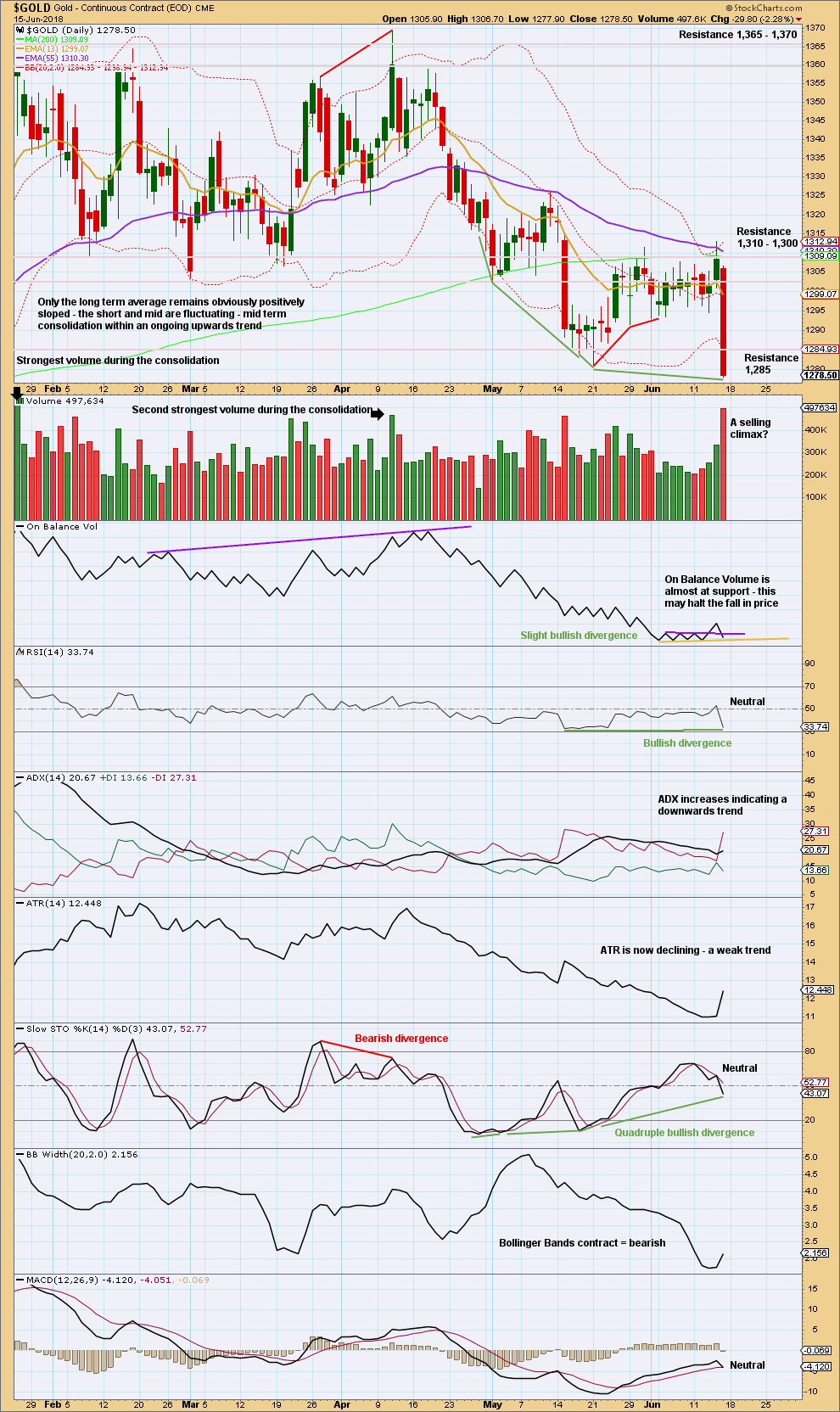
Click chart to enlarge. Chart courtesy of StockCharts.com.
It looks like the downwards breakout may still have been false, but before that can properly be concluded price needs to close back above 1,310. It has not done that yet.
Let us look back at major lows from November 2015 and see how price behaved in the days immediately after.
A major low was found on the 3rd of December, 2015. The following day for the 4th of December saw a strong Bullish Engulfing reversal pattern with support from volume, and it came with strong double bullish divergence between price and both of RSI and Stochastics. That low in hindsight looks fairly strong.
Another reasonable low was found on the 31st of May, 2016. There was no reasonable bullish divergence at the low between price and either of RSI or Stochastics. At the low, the candlestick had a bullish long lower wick (although with a reasonable upper wick, it is not properly a Hammer reversal pattern). The two days following the low for the 1st and 2nd of June were inconclusive; both closed red and could at the time have been considered a potential bear flag pattern developing; both had a balance of volume downwards but showed strongly declining volume. Not until the third day, with a very strong upwards day with support from volume to complete a very strong Bullish Engulfing reversal pattern, was a low set in place.
A major low was found on the 15th of December, 2016. At the low, the candlestick had a somewhat bullish long lower wick; volume for the last downwards day supported the fall in price; and, there was clear and strong bullish divergence between price and RSI and Stochastics. The next two days closed green but did not have support from volume. The following two days closed red and did have support from volume. At that stage, four days out from a major low, the short term volume profile was bearish and it looked like a bear flag pattern may be developing. It was not until seven days after the low on the 27th of December that a reasonable bullish day unfolded, and even then it did not have good support from volume. This low did not look clear.
The next low to study occurred on the 10th of March, 2017. That day was inconclusive, closing green, but the balance of volume was downwards and volume supported that downwards movement. At the low, there was no reasonable bullish divergence between price and either of RSI or Stochastics. It was not until three days after the low on the 15th of March that price bounced strongly to complete a strong Bullish Engulfing reversal pattern, which had good support from volume.
The next low to study occurred on the 9th of May, 2017. On that day RSI reached oversold, but there was no divergence between it and price nor price and Stochastics. Right up until six days after the low the short term volume profile could have been judged to be bearish; rising price did not have support from volume. It was clear a low was in place on the 17th of May as a very strong Bullish Engulfing reversal pattern unfolded with strong support from volume. The small bounce up until that date could have been judged to be a bounce within an ongoing downwards trend.
The next low to study occurred on the 10th of July, 2017. There was no divergence at the low between price and RSI, but there was strong clear bullish divergence between price and Stochastics. There were two candlesticks with bullish long lower wicks at the low, but volume remained lighter than the prior downwards day of the 9th of July. This looks like a selling climax in hindsight, but at the time it could have been judged to support downwards movement. Right up until the 14th of July, five days after the low, it could have been considered a bear flag pattern unfolding. On the 14th of July a strong Bullish Engulfing pattern unfolded with some support from volume.
The last low to study is a very important one on the 12th of December, 2017. This occurred after a downwards breakout below support, which was previously at 1,262. That downwards breakout was short lived; price remained below support for two weeks, and found a low only five days after the breakout. At the low, there was no bullish divergence between price and either of RSI or Stochastics. The first upwards day on the 13th of December had a wide range but a very small real body. It did have good support from volume, but volume remained lighter than most prior downwards days. After that low, price moved steadily higher for weeks, initially on light and declining volume. That low in hindsight was very difficult to pick.
Some conclusions may be drawn in relation to the current situation. The first and strongest conclusion is that lows for Gold (at least for the last two years and five months) are not always very clear at the time. Price can be weak in days immediately following lows; it can remain weak for about five to seven days following lows. Lows do not always come with divergence between price and RSI nor even price and Stochastics, but when they do that offers a clue.
Although the last few days have seen unexpected downwards movement, some suspicion may be had that this is a downwards breakout. ADX at this time indicates a downward trend is in place, but this is a lagging indicator. Look out for at least a short term bounce here, and do not be surprised if it begins to show some strength towards the end of this week. If it remains persistently weak, then short positions may be taken for a downwards trend (the new labelling for the fifth wave count could be correct). If it shows strength, that would support the first wave count; the downwards breakout may have been yet another false breakout.
At this stage, this daily chart is looking mostly bearish. But there is strong warning for the bearish case from now strong quadruple bullish divergence between price and Stochastics and weak bullish divergence between price and RSI.
A downwards trend is in place at this time. After a strong volume spike indicating a selling climax, a low may be reached not there but within a very few days. Look for new lows early next week as very likely. Next support is about 1,260.
GDX WEEKLY CHART

Click chart to enlarge. Chart courtesy of StockCharts.com.
Support about 20.80 has been tested about eight times and so far has held. The more often a support area is tested and holds, the more technical significance it has.
In the first instance, expect this area to continue to provide support. Only a strong downwards day, closing below support and preferably with some increase in volume, would constitute a downwards breakout from the consolidation that GDX has been in for a year now.
Resistance is about 25.50. Only a strong upwards day, closing above resistance and with support from volume, would constitute an upwards breakout.
Overall, a slow upwards swing may be underway. Do not expect it to move in a straight line; it may have downwards weeks within it.
GDX DAILY CHART
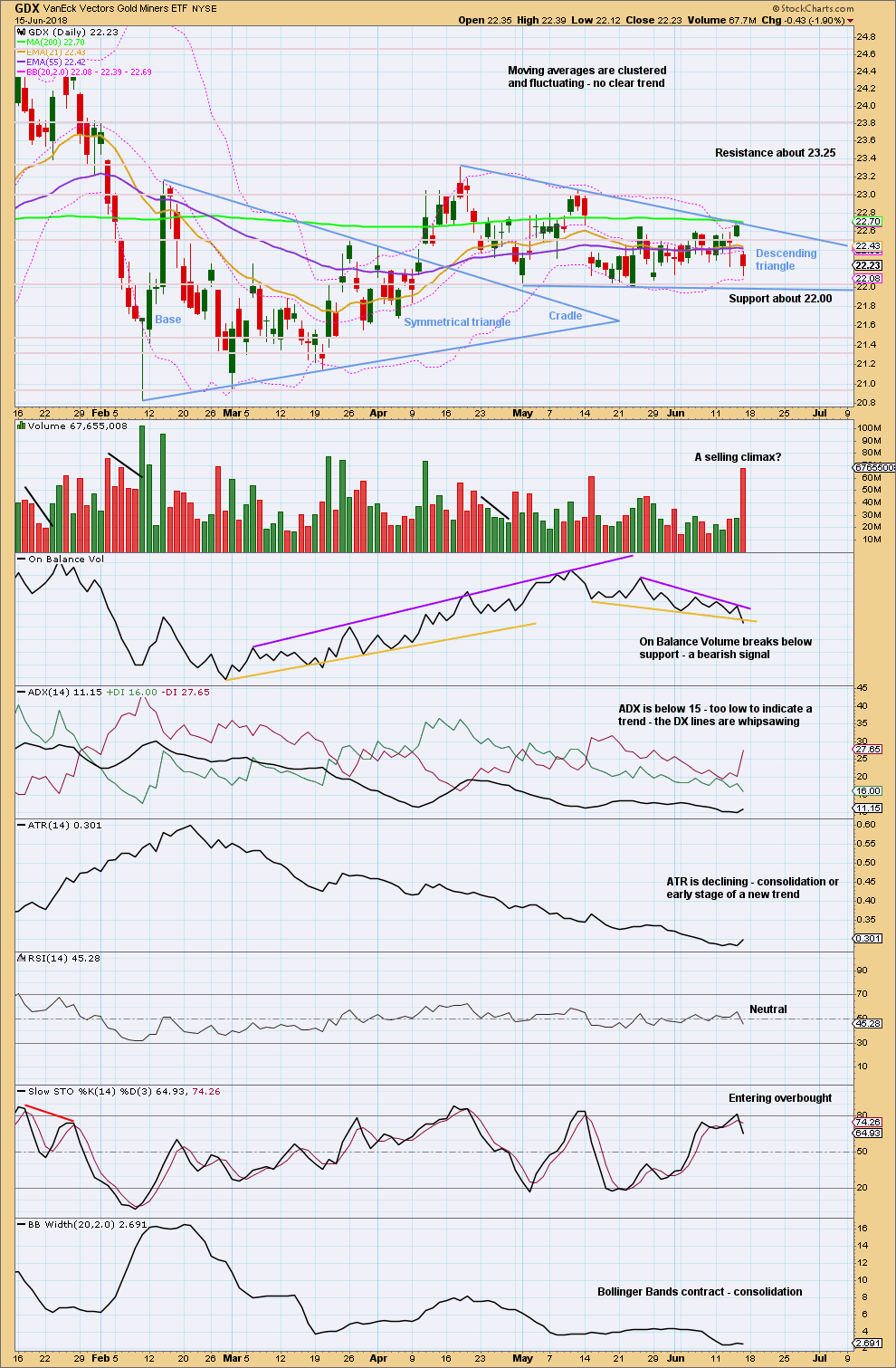
Click chart to enlarge. Chart courtesy of StockCharts.com.
The bearish signal from On Balance Volume suggests at least a little more downwards movement here. Next support is about 22.00, and thereafter about 21.45 and 21.35.
US OIL
For the short term, some upwards movement was expected for US Oil. Although Friday ended with very strong downwards movement, the week made a higher high and a higher low.
Summary: A deeper and longer lasting consolidation may have begun, which may last about 13 to 21 weeks in total. It should remain above 55.24, and the target is about 61.12. The consolidation will not move in a straight line; it may swing from resistance to support and back again in large swings. Once resistance and support are identified, then a swing trading system may be employed by more experienced traders. Support may be about 61.0 and resistance may be as high as 72.5 to 73.0.
Always practice good risk management as the most important aspect of trading. Always trade with stops and invest only 1-5% of equity on any one trade. Failure to manage risk is the most common mistake new traders make.
MAIN WAVE COUNT
MONTHLY CHART
It is possible that the bear market for Oil is over and a new bull market is in the very early stages.
A huge zigzag down to the last low may be complete and is labelled here Super Cycle wave (II).
Cycle wave b must be seen as complete in August 2013 for this wave count to work. It cannot be seen as complete at the prior major swing high in May 2011.
Cycle wave b is seen as a zigzag, and within it primary wave B is seen as a running contracting triangle. These are fairly common structures, although nine wave triangles are uncommon. All subdivisions fit.
Primary wave C moves beyond the end of primary wave A, so it avoids a truncation. But it does not have to move above the price territory of primary wave B to avoid a truncation, which is an important distinction.
If cycle wave b begins there, then cycle wave c may be seen as a complete five wave impulse.
Super Cycle wave (III) must move beyond the end of Super Cycle wave (I). It must move far enough above that point to allow room for a subsequent Super Cycle wave (IV) to unfold and remain above Super Cycle wave (I) price territory.
Cycle wave I may be incomplete. It may be unfolding as an impulse and may have now moved through the middle portion. Commodities have a tendency to exhibit swift strong fifth waves, and this tendency is especially prevalent for third wave impulses. Intermediate wave (5) to end primary wave 3 may be very swift and strong, ending with a blow off top.
When cycle wave I is complete, then cycle wave II may be a deep correction that may not move beyond the start of cycle wave I below 26.06.
Data from FXCM for USOil does not go back to the beginning of Super Cycle wave (I). Without an accurate known length of Super Cycle wave (I) a target cannot be calculated for Super Cycle wave (III) to end using Fibonacci ratios. The target for Super Cycle wave (III) may be calculated when cycle waves I, II, III and IV within it are complete. That cannot be done for many years.
WEEKLY CHART
Intermediate wave (3) may now be complete. There is no Fibonacci ratio between intermediate waves (1) and (3), and intermediate wave (3) is longer than 1.618 the length of intermediate wave (1).
This wave count fits with classic technical analysis at the monthly and daily chart levels.
Intermediate wave (2) was a deep double zigzag. Given the guideline of alternation, intermediate wave (4) may be expected to most likely be a shallow flat, triangle or combination. It may be about even in duration with intermediate wave (2), or it may be a little longer because triangles and combinations are more time consuming structures.
In the first instance, a Fibonacci 13 weeks may be expected for intermediate wave (4). If about that time the structure is incomplete, then the next Fibonacci number in the sequence at 21 will be expected.
Intermediate wave (4) may find support about the lower edge of the black Elliott channel. It may end within the price territory of the fourth wave of one lesser degree; minor wave 4 has its territory from 66.65 to 59.13.
DAILY CHART
If intermediate wave (4) unfolds as a double combination, flat or triangle, then the first wave down within it would be a three wave structure and most likely a zigzag.
All of a flat, combination or triangle may have within them a new high above the start of intermediate wave (4) at 72.90 as in an expanded flat, running triangle or wave X of a double combination. There can be no upper invalidation point for this reason.
This analysis will require alternate daily wave counts over the next few weeks. It is impossible at this stage to tell which of several possible structures intermediate wave (4) may be, only that it is least likely to be a single or multiple zigzag. Focus will be on identifying when intermediate wave (4) may be over.
At this stage, it looks like a zigzag is complete at the low labelled minute wave w. Upwards movement for this week looks weak; this looks like a counter trend movement, so it is labelled minute wave x. With minute wave x relatively brief and shallow, it looks like a double zigzag may be unfolding lower that may be minor wave A within a flat or triangle.
The purpose of a second zigzag within a double is to deepen a correction, so minute wave y may be expected to move below the end of minute wave w. At 61.80 minute wave y would reach 0.618 the length of minute wave w; this target is close to the 0.382 Fibonacci ratio at 61.12.
Intermediate wave (4) may not move into intermediate wave (1) price territory below 55.24.
ALTERNATE WAVE COUNT
MONTHLY CHART
Within the bear market, cycle wave b is seen as ending in May 2011. Thereafter, a five wave structure downwards for cycle wave c begins.
Primary wave 1 is a short impulse lasting five months. Primary wave 2 is a very deep 0.94 zigzag lasting 22 months. Primary wave 3 is a complete impulse with no Fibonacci ratio to primary wave 1. It lasted 30 months.
There is now little alternation in depth between primary waves 2 and 4. Primary wave 2 is very deep, but primary wave 4 is also now deep. There is inadequate alternation in structure, both are zigzags. The lack of alternation in this wave count must reduce its probability. So far primary wave 4 has lasted 27 months. At this stage, there is still reasonable proportion between primary waves 2 and 4.
Primary wave 4 may not move into primary wave 1 price territory above 74.96.
The wider Elliott channel (teal) about this whole movement may offer support to primary wave 5.
WEEKLY CHART
This wave count now expects a huge trend change for a new wave down for primary wave 5, which may last about a year or so. Primary wave 5 would be likely to make at least a slight new low below 26.86 to move below the end of primary wave 3 and avoid a truncation.
An Elliott channel is added to this possible zigzag for primary wave 4. A breach of the lower edge of this channel would provide a very strong indication that primary wave 4 should be over and primary wave 5 should be underway. Look out for some support on the way down, perhaps a short term bounce about the lower edge of the channel.
A new low now below 55.24 would invalidate the main wave count and in turn offer some confidence to this alternate.
DAILY CHART
This wave count now expects a new wave down at primary degree. That should begin with a five down on the daily chart. Within the new wave down, minor wave 2 may not move beyond the start of minor wave 1 above 72.90.
Minor wave 2 may be unfolding as an expanded flat correction. These are very common structures.
Within minor wave 2, minute wave b may be an incomplete zigzag. While there is no Elliott wave rule stating a maximum limit for B waves within flat corrections, there is a convention that states when the possible B wave is longer than twice the length of the A wave, the idea of a flat should be discarded based upon a very low probability. Here, that point would be at 62.96.
TECHNICAL ANALYSIS
MONTHLY CHART

Click chart to enlarge. Chart courtesy of StockCharts.com.
The candlestick now completed for the month of May is very bearish. Although price moved higher, the candlestick closed red and the long upper wick is very bearish. Support from volume for downwards movement within the month is bearish.
However, there remains strong bullish divergence between price and On Balance Volume. With On Balance Volume a leading indicator and making new highs above prior highs back in June 2014, price may be likely to follow with new highs above this date.
The larger trend still may be upward, but here a reasonable consolidation may have begun. It is for this reason that the Elliott wave count expects an intermediate degree correction just beginning.
DAILY CHART

Click chart to enlarge. Chart courtesy of StockCharts.com.
Price has again found support about 64.20, and it has not made a new low below the prior low of the 5th of June.
Overall, this chart is neutral.

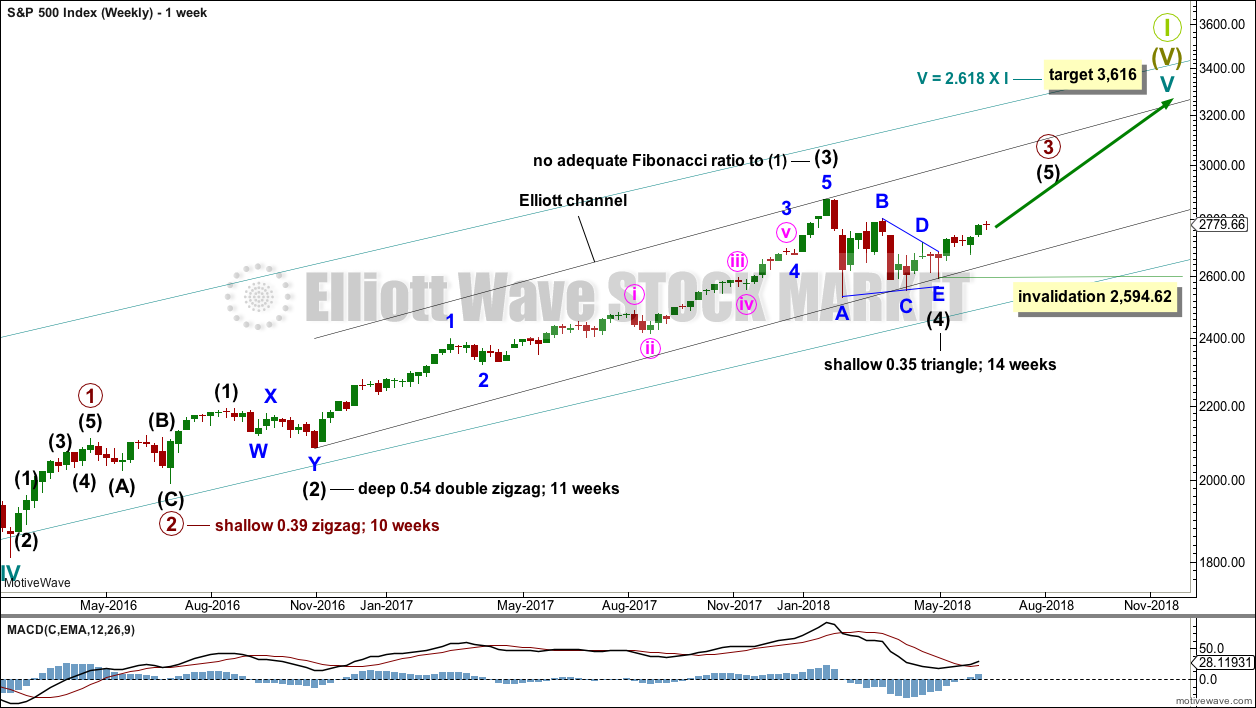

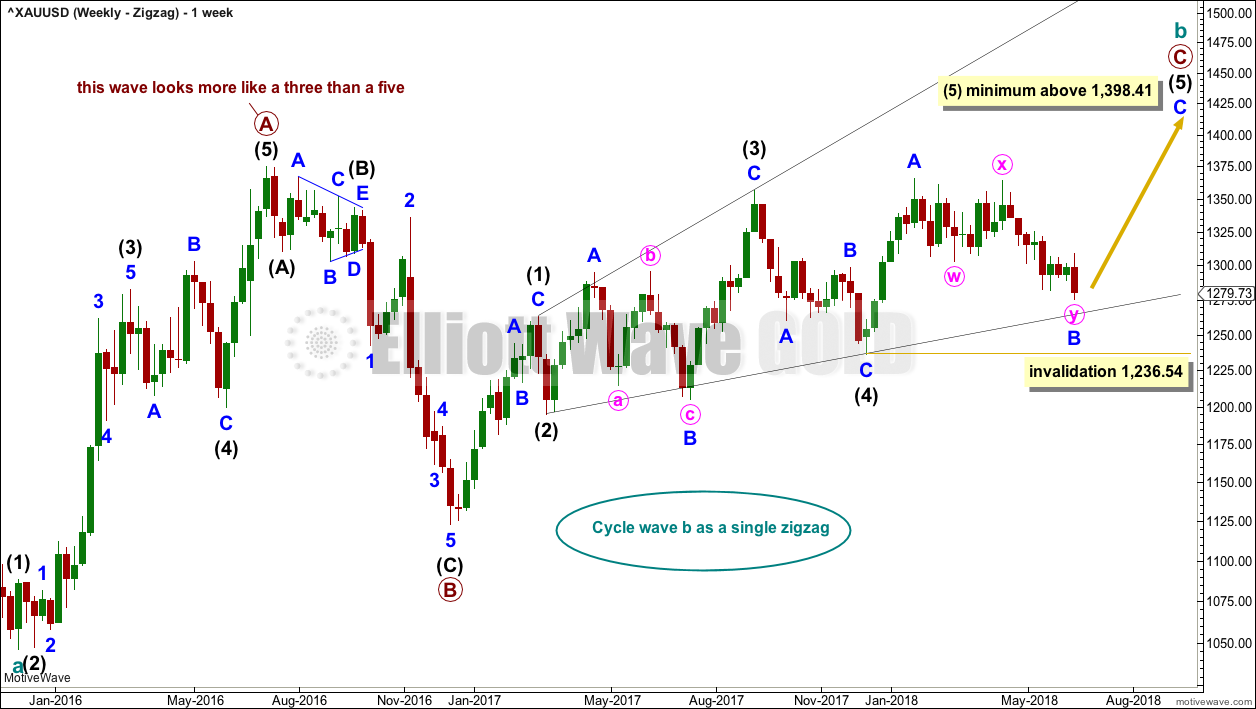
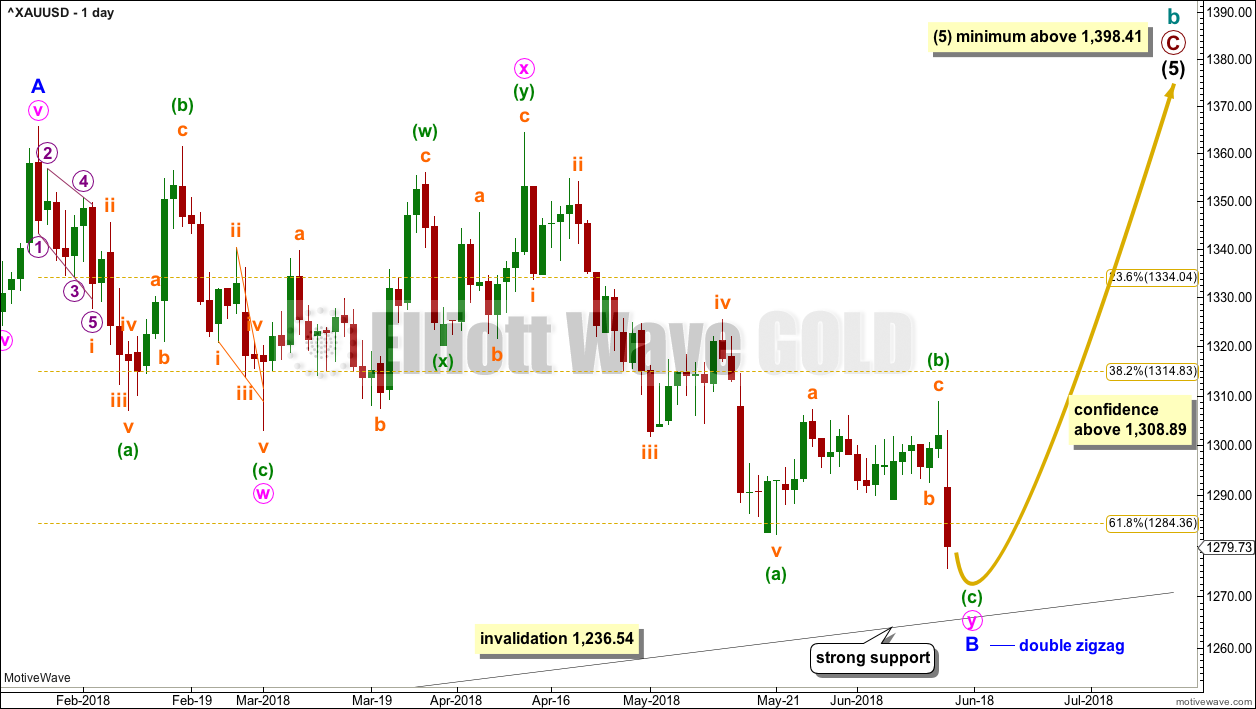
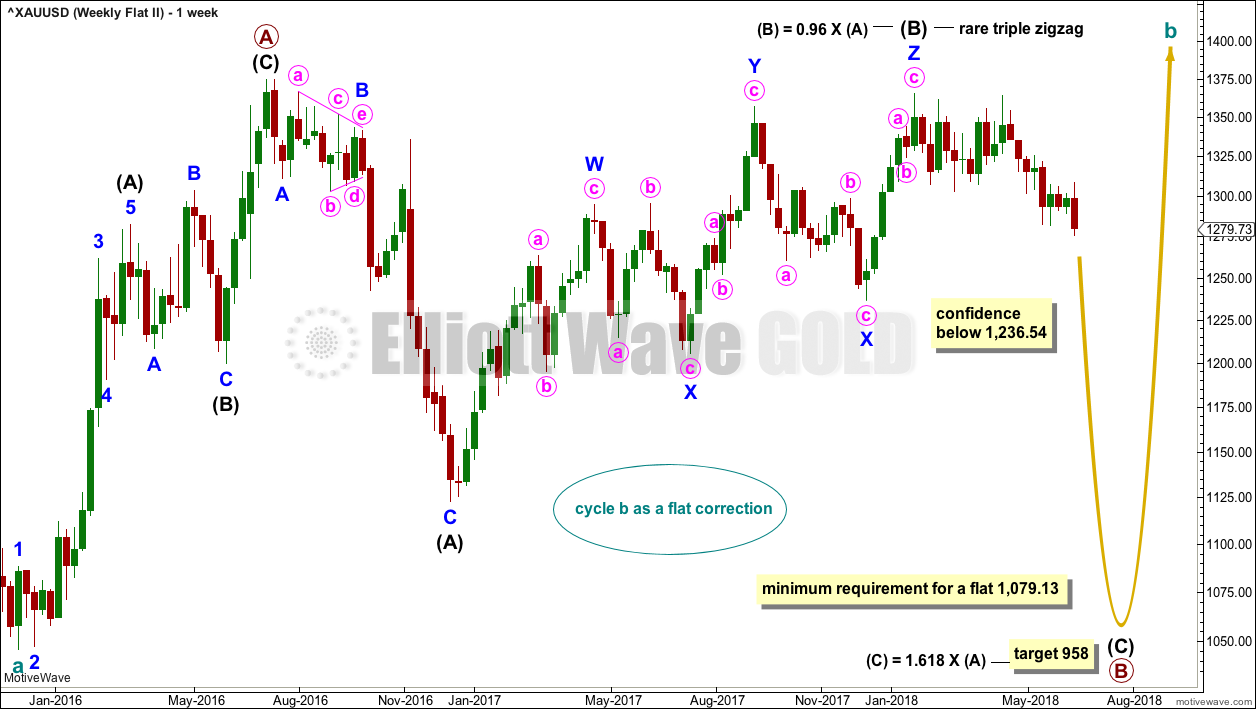
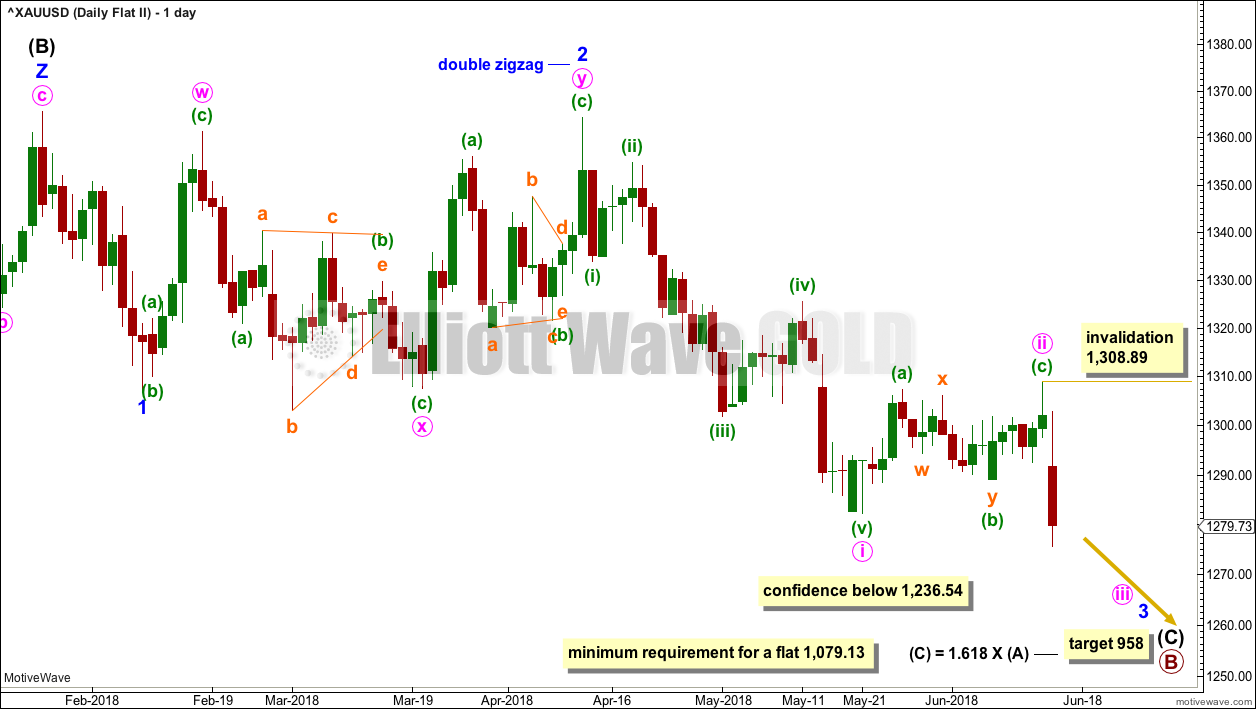
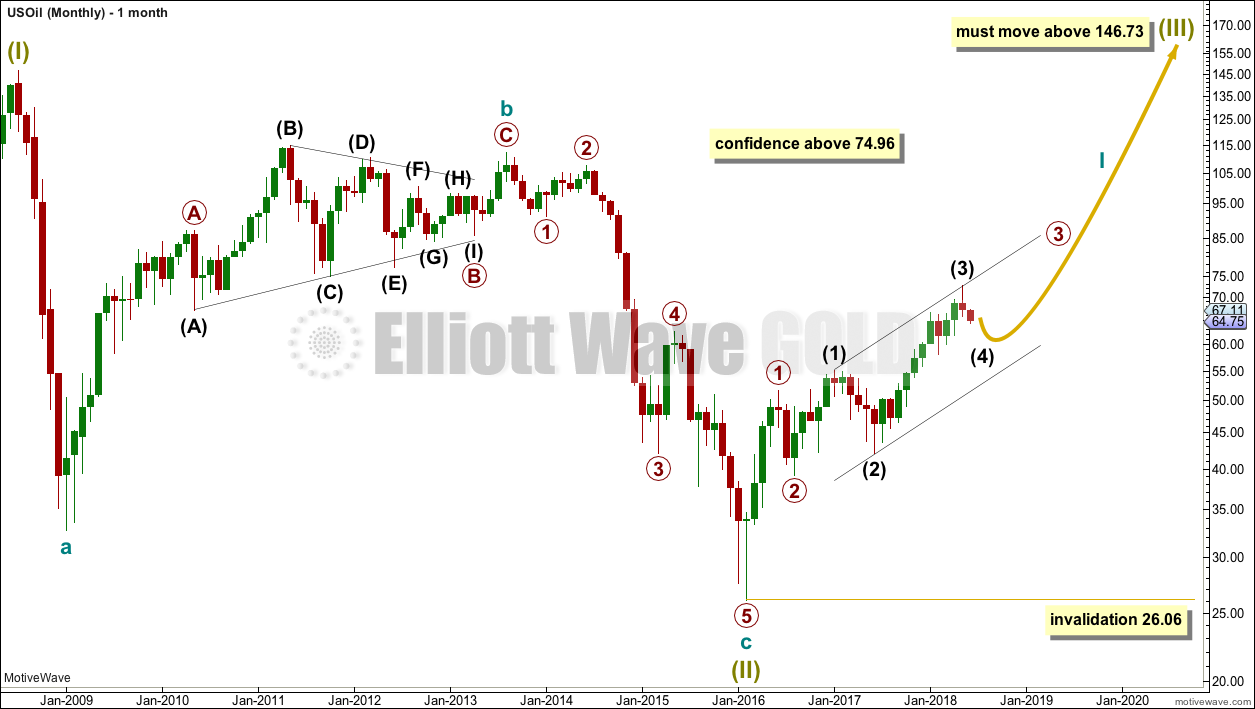
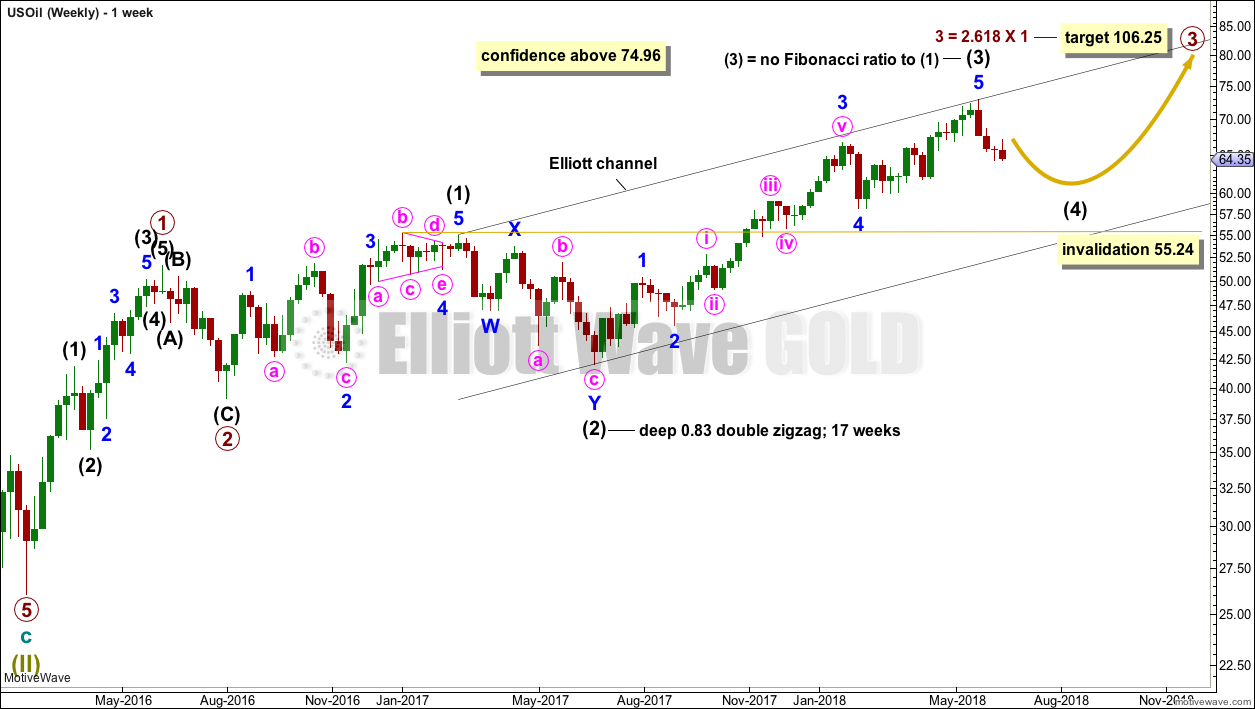
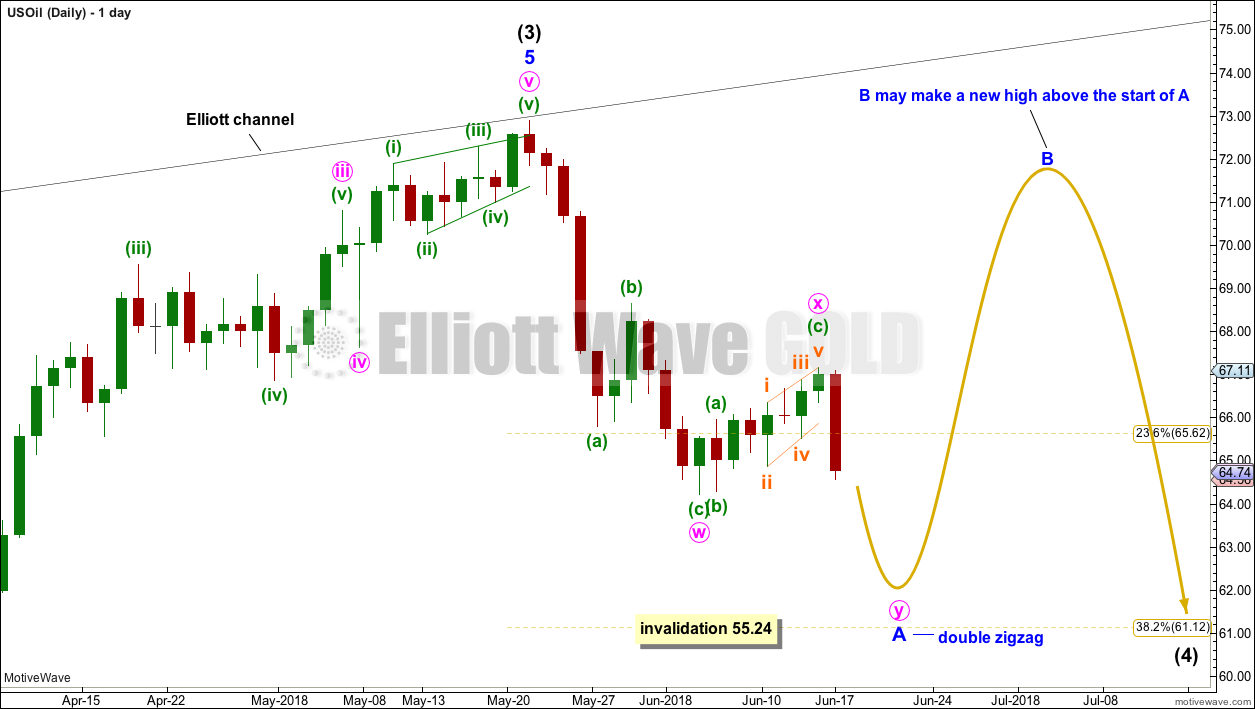
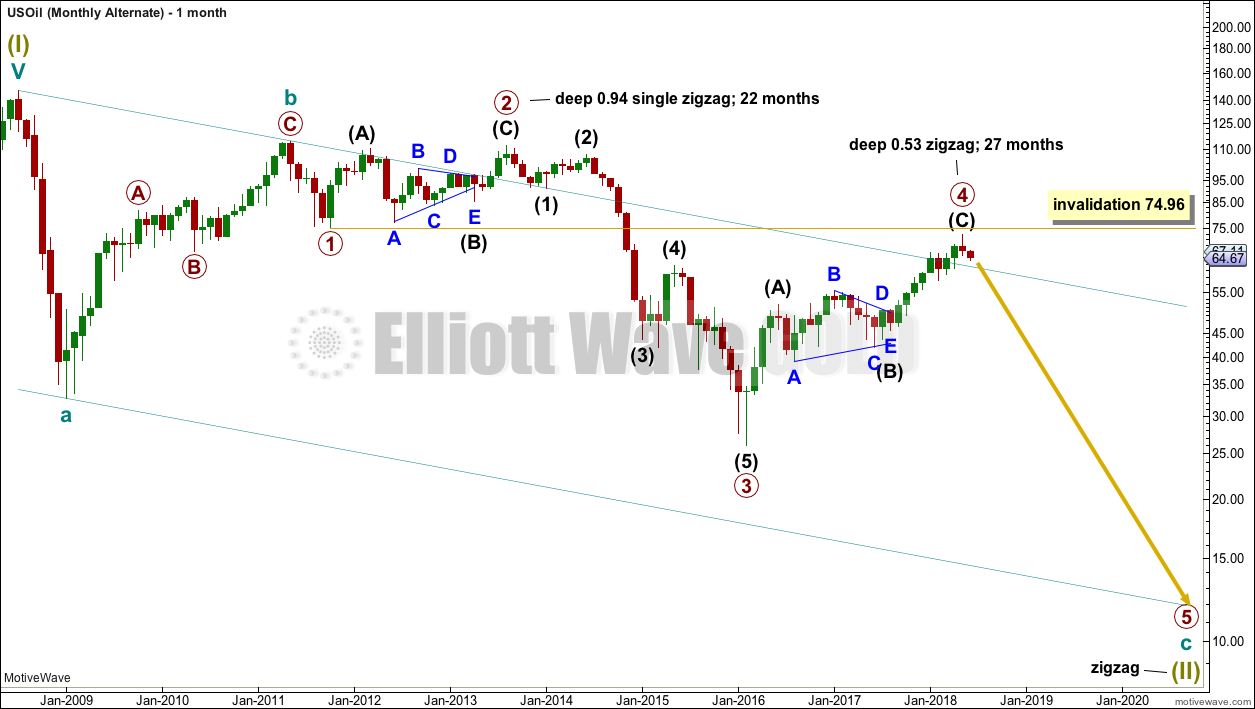

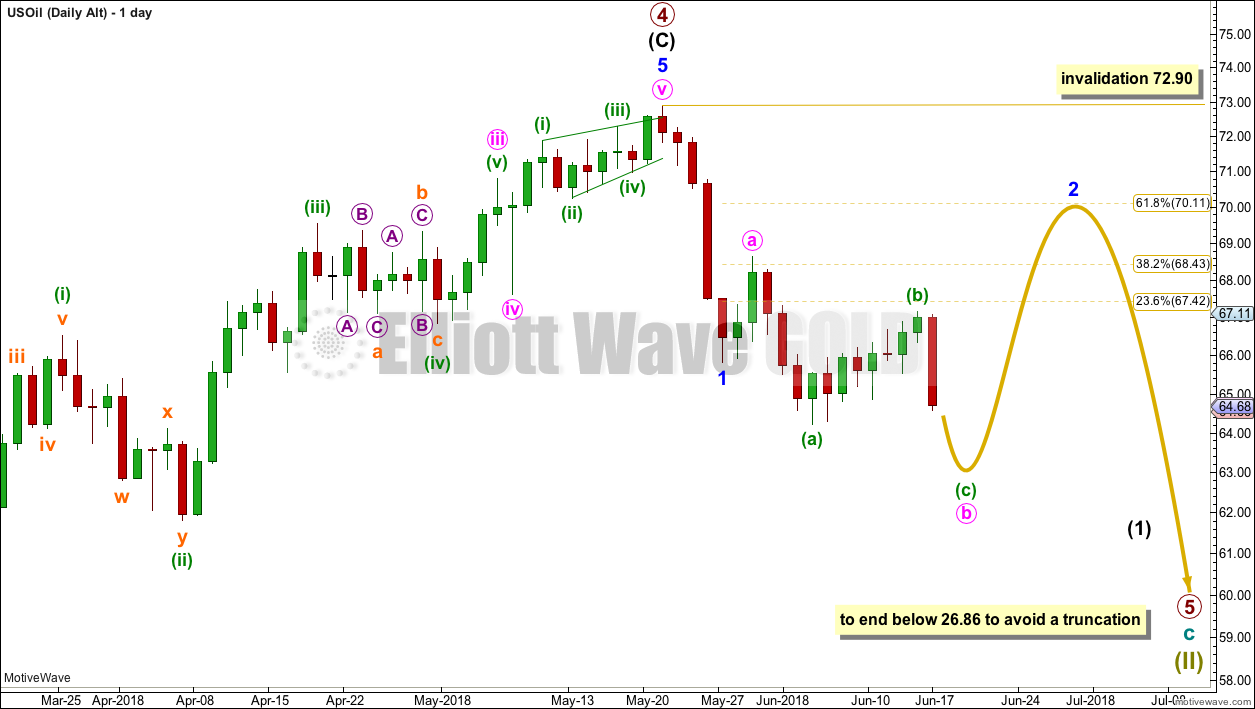
Thanks Lara for the updates and opportunity to see the full Gold analysis. I think you are on to something with the triangle count. Knowing when to stay out of a trade or market is just as important as knowing when to get in. For me, I want to see the daily count clear up. Thanks again.
Me too. I’m wanting to see cycle wave b become clear.
Sadly, B waves often are not clear until right up to the end… and sometimes not even then.
Because when we have a complete corrective structure I shall then have to consider the alternate idea of moving it all down one degree, and conceding that the complete structure is only wave A.
Unless of course the whole thing completes as a triangle. A waves can’t subdivide as triangles.
A notice to all Lara’s Weekly members:
I’ve updated the historic analysis for Gold today and you too shall have access to this as it’s the big picture. There is a video to come too.
Lara,
Thank you very much for the update today. It now opens up a whole new possibility. This market is by no means lacking in ‘fun’ !! I now understand the B wave nightmare. And to think that after completing cycle wave c, we will be starting another b wave, this time at the Super Cycle level is totally ‘awesome’ !!!
In the video, at the 7:30 minute mark, you mentioned that “Four of the five subwaves of a triangle must be simple A-B-C corrective structures, only one sub wave can be a more complicated multiple. And four of the five sub waves must be zigzags or multiple zigzags.”
If “four of the five sub waves must be zigzags or multiple zigzags.”, does it mean that it is possible to have more than one multiple zigzag in a triangle corrective structure, please?
Thank you kindly.
Dave
A good question, and I’ve not really made myself clear there, have I.
It’s kinda difficult to state really clearly. I’ll have another go.
The rules are:
– only one triangle sub-wave may be a multiple corrective structure
– only one triangle sub-wave may be a structure which is not a zigzag or multiple zigzag
And so, interpreting these two rules gives us:
A triangle may only have one multiple which is usually a double zigzag and this is usually wave C. The remaining sub-waves must be simple A-B-C corrective structures, and all of those remaining four must be zigzags except for one which can be another kind of structure (like a flat), except they are all usually zigzags.
Does that make sense?
And I’ll add: yes, when cycle c down completes a huge zigzag, then we shall have the multi year problem of what structure is Super Cycle wave (b). I do not see Gold analysis becoming “easy” at that point.
Cycle c down may give us some reprieve for a year or so.
Perfect and thank you, Lara.
A few rules in EWT are slightly ambiguous and that is where we rely completely on the value of your experience. Normally the A subwaves are the ones that mimic a multiple zigzag and need expertise to fit as single zigzags. The sideways extended C subwaves are relatively ‘easier’ to identify as the multiple. That being said ‘easy’ is a relative term as far as EWT goes!
Once the Super Cycle (b) starts, it would have to be your expertise that would guide us.
Lara,
My chart of gold using Bill Williams methods. 1264 gives us a 61.8 % retracement I also notice DX is showing divergence with Oscillators. I think SPX is acting something other than impulsive. Futures has some over lap but not with cash (SPX). Closing price is ending strong but why, it doesn’t add up.
Thanks Bill. I also notice divergence there between Gold price and oscillators.
As for the S&P, I expect it’s in a fifth wave, and it’s towards the end of a huge bull market, so I’d be expecting it to now show some internal weakness. Perhaps considering it in that context it may make some sense?
In the summary on SPX, Lara writes: “Pullbacks are an opportunity to join the trend. ”
The correction of yesterday and again today (Tuesday, 6/19) seems to be one such opportunity. Futures are down 27 points before the open. This will take us to the 2750 area and the lower channel line of the recent advance. This area should provide support.
One can go long here with a relatively tight stop loss point yet a high reward potential.
This is not trading or investment advice, just my opinion. What do others think?
Also, the June 1st gap with the lower point at 2736 should provide support.
That’s what I’m doing. With another slight new low today and price finding support at the blue base channel on the S&P daily chart, I’m considering adding to my long position.
Are we to gather by the analysis above that you are referring to the Fifth Weekly Chart as the alternate Elliot Wave count for gold–the count we are presently in? So then, we are looking at a very bearish outlook for some time to come.
No. There are five weekly charts, the fifth one is the most bearish.
The first weekly chart which is my main wave count now is still the first weekly chart. My alternate that I publish for you each week is the fifth weekly chart.
BUT we need to see a new low below 1,236.54 before that very bearish outlook could be taken seriously.
You are marvelous! I didn’t overstate that did I?
No, it’s all good.
And, thank you!